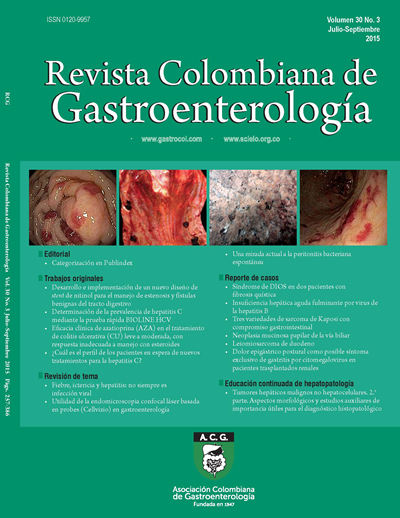Neoplasia mucinosa papilar de la vía biliar: reporte de caso
DOI:
https://doi.org/10.22516/25007440.60Keywords:
Colestasis, neoplasia mucinosa, colangioscopiaAbstract
La neoplasia mucinosa papilar es una enfermedad muy rara que usualmente se describe como ubicada en la vía pancreática. Presentamos un caso de una mujer con esta enfermedad aunque localizada en la vía biliar, lo cual es aún más infrecuente y constituye el primer caso descrito en Colombia. Hacemos una revisión de la literatura y una descripción de los exámenes que se usaron para llegar al diagnóstico, que incluyeron la utilidad de una nueva herramienta como es el Spyglass.
Downloads
References
Kubota K, Nakanuma Y, Kondo F, et al. Clinicopathological features and prognosis of mucin-producing bile duct tumor and mucinous cystic tumor of the liver: A multi-institutio- nal study by the Japan Biliary Association. J Hepatobiliary Pancreat Sci. 2013;39:123-130.
Minagawa N, Sato N, Mori Y. A comparison between intra- ductal papillary neoplasms of the biliary tract (BTIPMNs) and intraductal papillary mucinous neoplasms of the pan- creas (P-IPMNs) reveals distinct clinical manifestations and outcomes. EJSO. 2013;39:554-8.
Kim BS, Joo SH, Lim SJ, et al. Intrahepatic Biliary Intraductal Papillary Mucinous Neoplasm With Gallbladder Agenesis: Case Report. Surg Laparosc Endosc Percutan Tech. 2013;23:e61-4.
Barton JG, Barrett DA, Maricevich MA, et al. Intraductal papillary mucinous neoplasm of the biliary tract: A real disease? HPB. 2009;11:684-91.
Chang WF, Huang GS, Chang WC. An unusual but important cause of biliary obstruction. Gastroenterology. 2013;145:59-62.
Lim JH, Jang KT, Choi D. Biliary intraductal papillary mucinous neoplasm manifesting only as dilatation of the hepatic lobar or segmental bile ducts: imaging features in six patients. AJR. 2008;191:778-82.
Lim JH, Yi CA, Lim HK, Lee WJ, Lee SJ, Kim SH. Radiological spectrum of intraductal papillary tumors of the bile duct. Korean J Radiol. 2002;3(1):57-63.
Zen Y, Fujii T, Itatsu K, et al. Biliary papillary tumors share pathological features with intraductal papillary mucinous neoplasm of the pancreas. Hepatology. 2006;44(5):1333- 43.
Nakanuma Y, Curado M, Fransceschi S, et al. “Intrahepatic
cholangiocarcinoma” in WHO Classification of tumours of the digestive system. Bosman F, Carneiro F, Hruban RH, Theise ND (editors). 4th edition. Lyon, France: IARC; 2010. p. 217-27.
Zen Y, Fujii T, Itatsu K, et al. Biliary cystic tumors with bile duct communication: A cystic variant of intraduc- tal papillary neoplasm of the bile duct. Modern Pathol. 2006;19(9):1243-54.
Ohtsuka M, Kimura F, Shimizu H, et al. Similarities and differences between intraductal papillary tumors of the bile duct with and without macroscopically visible mucin secre- tion. Am J Surg Pathol.
;35(4):512-21.
Rocha FG, Lee H, Katabi N, et al. Intraductal papillary neo- plasm of the bile duct: A biliary equivalent to intraductal papillary mucinous neoplasm of the pancreas? Hepatology. 2012;56(4):1352-60.
Onoe S, Shimoyama Y, Ebata T, et al. Prognostic delinea- tion of papillary cholangiocarcinoma based on the invasive proportion: A single-institution study with 184 patients. Surgery. 2014;155(2):280-91.
Yeh C, Jan Y, Yeh T, Hwang T, Chen M. Hepatic resection of the intraductal papillary type of peripheral cholangiocarci- noma. Ann Surg Oncol. 2004;11(6):606-11.
Kim KM, Lee JK, Shin JU, et al. Clinicopathologic features of intraductal papillary neoplasm of the bile duct according to histologic subtype. Am J Gastroenterol. 2012;107(1):118-25.
Jung G, Park KM, Lee SS, et al. Long-term clinical outcome of the surgically resected intraductal papillary neoplasm of the bile duct. J Hepatology. 2012;57(4):787-93.
Yang J, Wang W, Yan L. The clinicopathological features of intraductal papillary neoplasms of the bile duct in a Chinese population. Digest Liver Dis. 2012;44(3):251-6.
Downloads
Published
How to Cite
Issue
Section
License
Aquellos autores/as que tengan publicaciones con esta revista, aceptan los términos siguientes:
Los autores/as ceden sus derechos de autor y garantizarán a la revista el derecho de primera publicación de su obra, el cuál estará simultáneamente sujeto a la Licencia de reconocimiento de Creative Commons que permite a terceros compartir la obra siempre que se indique su autor y su primera publicación en esta revista.
Los contenidos están protegidos bajo una licencia de Creative Commons Reconocimiento-NoComercial-SinObraDerivada 4.0 Internacional.




















